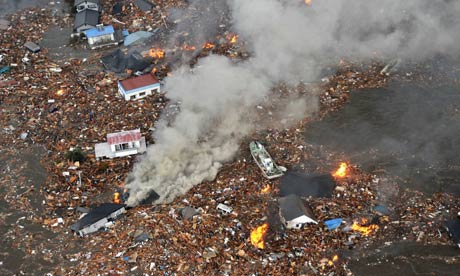Here's a summary of the aftermath of today's earthquake and massive tsunami in Japan:
• An earthquake measured at 8.9 magnitude by the US Geological Survey, the sixth biggest since 1900, struck Japan today. The USGS has recorded more than 50 subsequent earthquakes.
• The earthquake triggered a tsunami with 10m-high waves hitting the northern port of Sendai. Waves have swept across farmland, sweeping away homes, crops, vehicles, triggering fires. Tsunami warnings and watches have been issued in dozens of other countries.
• The death toll has been rising throughout the day. Police have just said 200 to 300 drowned bodies have been found in Sendai. A ship carrying 100 people was swept away by the tsunami, according to the Kyodo news agency. Reuters is reporting that a train is unaccounted for in coastal areas affected by the tsunami.
• A state of emergency has been declared at a nuclear plant in Fukushima. The authorities said there was no radiation leak but people within 2km of the plant have reportedly been told to evacuate their homes.
• The Japanese prime minister Naoto Kan urged people to help their neighbours and to act to "minimise the damage". "We ask the people of Japan to exercise the spirit of fraternity, help each other and act fast," he said.
• The tsunami has reached Hawaii, with rising waters reported but no significant impact is expected when it reaches the US mainland around coastal Oregon and northern California.
For earlier updates, read the Guardian's previous live blog here.
Mathew Honan is a resident of Ocean Beach in San Francisco, where the tsunami is expected to hit shortly. He's set up a live webcam with a view of the beach, which you can see here.
The Guardian's Justin McCurry in Tokyo emails to say that the Kyodo news agency is reporting that radiation levels are rising at the Fukushima Daiichi nuclear plant turbine building, but doesn't give a source.
Robyn Gallagher is a New Zealander visiting Tokyo, and she has blogged her reaction to feeling the quake from inside Shinjuku railway station, said to be the busiest train station in the world with two million people using it each day:
It wasn't the sort of gentle Wellington quake that I'm used to. It was this weird swaying, like standing on a platform on top of a giant spring.
It actually took a little while to figure out that it was an earthquake and not a random Japanese public transport bump. When I realised, I headed for a wall, fearful of debris, though the building seemed to be intact. My mental what-if earthquake plan, formulated post-Christchurch, was put into full effect.
After the swaying stopped – except it didn't so much stop as just slow down – I noticed that everyone around was not panicked or freaking out. There was a general sense of calmness.
The Tokyo Electric Power company (Tepco) is the source of the news that the pressure inside the No 1 reactor at its Fukushima Daiichi nuclear plant has been rising, with the risk of a radiation leak, reports Jiji News via Reuters.
Tepco says it plans to take measures to release the pressure, the report added. No comment was immediately available from Tepco.
In this video you can see skyscrapers in Japan swaying in unsettling fashion during one of the earthquakes there today – as they are designed to do.
Hoisted from the comments from our previous live blog is this from reader SaffronHS in Tokyo, who has decided to stay in the office for the night:
We are feeling rather sick, both from devastating news and dizziness of actual shaking. Odakyu line (departs from Shinjyuku and goes into Kanagawa) started running again, and will be running through the night, but some of us decided it's better waiting until the sun is up; it's cold outside, and we are not sure if we can get onto the train at all - it must be fully packed now, and might not be able to get on board.
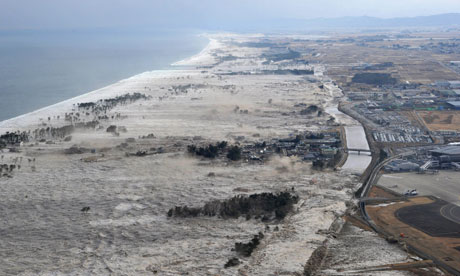 Earthquake-triggered tsumani sweep along the coast in Iwanuma, northern Japan. Photograph: AP
Earthquake-triggered tsumani sweep along the coast in Iwanuma, northern Japan. Photograph: AP
The Japanese media are reporting that the death toll is expected to exceed 1,000, most of whom appeared to have drowned. And that figure could rise significantly once the waters recede.
President Obama is giving a press conference at the White Hoiuse and begins with a statement on the earthquake and tsunami. Obama says he has told the Japanese government that the US stands ready to provide any assistance it needs.
"Our hearts go out to our friends in Japan and across the region," Obama said.
The president also spoke of the tsunami heading for the US west coast, and underlined the need for residents to stay away from low-lying coastal areas and to respect evacuation orders.
The Twitter feed of singer-songwriter Blaise Plant gave a dramatic minute-by-minute account of the earthquake and its aftermath near Sendai, one of the hardest-hit parts of Japan:
1507: My house is trashed! I'm ok! It was spooky...the biggest one yet!!
1647: Hey Everyone! It seems to have calmed down a bit.from where I am.the buildings are all busted up..massive billboards on the verge of falling
1648: I urge everyone to keep alert...things are falling all over the place... I heard tsunami looks pretty big on TV
1649: I currently can't go home the ground is still shaking and shaking
1716: So far a lot of people from the neighborhood gathered together to keep warm.
1724: Still big shakes...the tsunami seems to have really done damage... Looks as though there are deaths...but I can't be sure on that.
1828: The city is a complete black out! Can't see anything except car lights!!
1841: Gotta go pick up my cousin at Sendai station...I hope she's alright
1850: I'm standing in the middle of the city...pitch Black
1932: Thank god we live in a great, organized country where everyone is helping each other out!
So far, rising waters of around seven feet (just over two meters) have been reported on the coast of Oregon, where residents have evacuated low-lying areas. But there have been no reports of damage there or in northern California.
There are reports of surfers in Santa Cruz, California, out on the water attempting to ride the tsunami swells.
The Guardian Comment is Free section has an account of the earthquake from Cecilia Fujishima, a student and English language teacher living in Tokyo:
This time, the epicentre was off the Sanriku coast in Iwate and Miyagi prefectures, 300km from Tokyo.... The settled areas of the picturesque Sanriku coast have low-lying fishing villages with an acute awareness of tsunami. The tsunami flood gates and inundation zone warning signs along the coast are a stark reminder of the 1896 Sanriku tsunami in which more than 20,000 people died.
Japan's defence ministry has given the latest official estimate of the death toll, saying it expected the number of deaths to be more than 1,000, following the devastation in the Fukushima prefecture.
An urgent flash from the Kyodo news agency:
Radiation level rising in Fukushima nuclear plant turbine building
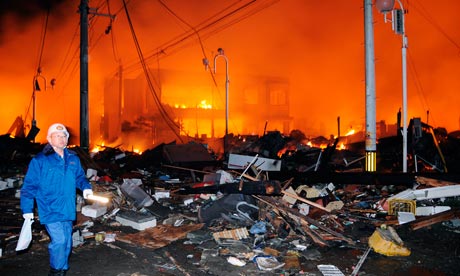 Rubble and a burning building in Fukushima prefecture. Photograph: AP
Rubble and a burning building in Fukushima prefecture. Photograph: AP
Japanese authorities are now warning that the pressure is still rising at the Fukushima Daiichi No 1 nuclear power plant after its cooling system failed, with 3,000 residents being moved out of the area after the government issued a state of emergency.
Japan's nuclear safety agency says pressure inside the reactor has risen to 1.5 times the level considered normal. To reduce the pressure, slightly radioactive vapor may be released – but the agency said the radioactive element in the vapor would not affect the environment or human health.
The agency says staff are trying to restore cooling water supply at the plant but "there is no prospect for an immediate success," according to AP.
Asked by a Japanese journalist what sort of practical assistance the US plans to offer Japan, President Obama says the most useful will be heavy lifting equipment.
Obama then says he feels a personal connection because he grew up in Hawaii. "I'm very confident that the Japanese people are so resourceful ... that Japan will successfully rebuild," he said.
Fears of significant tsunami impact has receded in many parts of the Asia-Pacific area. Tsunami alerts have now been lifted in Australia, New Zealand, Indonesia and the Philippines.
Japanese authorities will release radioactive vapor to ease pressure at the Fukushima Daiichi nuclear reactor, it has just been announced.
More to come on this.
More details on the planned release of radioactive vapour to reduce pressure on the damaged Fukushima Daiichi nuclear plant, where Japan's nuclear safety agency said pressure in one of six boiling water reactors had risen to 1.5 times the level considered normal.
The Associated Press reports:
After the quake triggered a power outage, a backup generator also failed and the cooling system was unable to supply water to cool the 460-megawatt No. 1 reactor, though at least one backup cooling system is being used. The reactor core remains hot even after a shutdown.
The agency said plant workers are scrambling to restore cooling water supply at the plant but there is no prospect for immediate success.
Chief Cabinet Secretary Yukio Edano said the 40-year-old plant was not leaking radiation. The plant is in Onahama city, about 170 miles (270 kilometers) northeast of Tokyo.
If the outage in the cooling system persists, eventually radiation could leak out into the environment, and, in the worst case, could cause a reactor meltdown, a nuclear safety agency official said on condition of anonymity, citing sensitivity of the issue.
Another official at the nuclear safety agency, Yuji Kakizaki, said that plant workers were cooling the reactor with a secondary cooling system, which is not as effective as the regular cooling method.
Kakizaki said officials have confirmed that the emergency cooling system — the last-ditch cooling measure to prevent the reactor from the meltdown — is intact and could kick in if needed.
"That's as a last resort, and we have not reached that stage yet," Kakizaki added.
A nuclear expert speaking to CNN said that "a worst case scenario" was a Chernobyl-style meltdown if power and cooling could not be restored. But he stressed that it was a remote possibility.
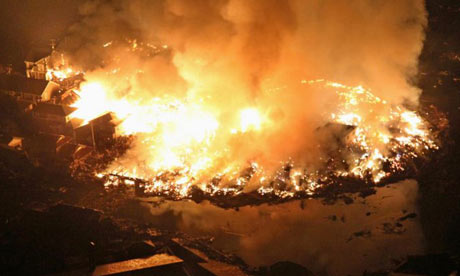 Houses continuing to burn in Miyagi prefecture after Friday's earthquake. Photograph: Kyodo/AP
Houses continuing to burn in Miyagi prefecture after Friday's earthquake. Photograph: Kyodo/AP
NHK television is still showing footage of a very large section of Kesennuma – a town of 70,000 people in Miyagi province – ablaze, with firefighters unable to put it out.
According to military observers who have looked at the fires from the air, the blaze covers a strip 4.5km wide and 2.5km deep.
The Emergency in SF Twitter account has posted this tweet for San Francisco residents.
A 6.6 magnitude shock has just been reported in the Nagano Niigata area of Japan, apparently on a different faultline from the 8.9 magnitude quake earlier.
The US Geological Survey has said the new quake around Nagano a few minutes ago was measured at 6.2 magnitude – a big quake in most places. It's 4.23am in Japan and I suspect quite a few people have had an early wake-up jolt.
Ecuador's president Rafael Correa has declared a national state of emergency and urged coastal and island residents to evacuate fast to higher areas, as the tsunami approaches.
Police in Miyagi prefecture say 200-300 bodies have been found in the northeastern coastal city of Sendai, the city closest to the epicenter of today's first earthquake. Another 151 were confirmed killed, with 547 missing. Police also said around 800 people were injured.
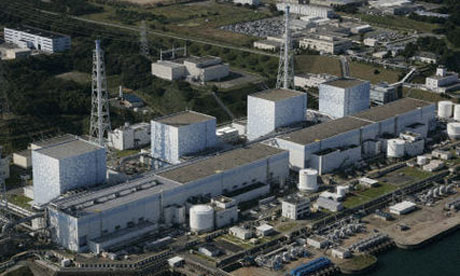 A file photo of the Fukushima Daiichi nuclear power plant in Onahama
A file photo of the Fukushima Daiichi nuclear power plant in Onahama
A Japanese minister says a radioactive leak likely to come from the damaged nuclear plant in Fukushima – 240km (150 miles) north of Tokyo – is expected to be small. Reuters reports:
"It's possible that radioactive material in the reactor vessel could leak outside but the amount is expected to be small and the wind blowing towards the sea will be considered," Chief Cabinet Yukio Edano told a news conference.
"Residents are safe after those within a 3km radius were evacuated and those within a 10km radius are staying indoors, so we want people to be calm," he added.
The plant's operator, Tokyo Electric Power Co, said pressure had built up inside a reactor at the plant after the cooling system was knocked out by the earthquake, the largest on record in Japan. The company had been operating three out of the six reactors at the Fukushima Daiichi plant at the time of the quake, all of which shut down. The remaining three had already been shut down for planned maintenance.

Felicity Carus is on the west coast of the US, watching the reaction to the huge waves generated by the tsunami arriving there:
Tens of thousands of people were evacuated from coastal and low lying areas along the west coast of the US this morning as seven-foot waves generated by the 8.9 earthquake near Japan first struck the US mainland coast at Crescent City, 20 miles south of the Oregon border.
The West Coast and Alaska Tsunami Warning Centre issued a warning for the California coast after waves travelled at 500 miles an hour across the Pacific, hitting Hawaii with waves up to 11ft high.
The first surges hit the US mainland at around 7.30am local time. Schools, highways and national parks were closed as authorities urged people to stay away from beaches, jetties and harbours.
Sirens sounded across Crescent City in far northern California in the early morning and police went door to door evacuating homes in the tsunami impact zone along the coast as fishermen left the busy harbour. A tsunami in 1964 devastated Crescent City and killed 11 people. Surges were expected continue to hit the California coast for up to 12 hours.
In the event, Crescent City experienced increasingly large waves from 3ft at 8.15am rising to 8.1ft at 10.15am. Some 6,000 people were evacuated from Crescent City town and police have sealed off the harbour.
In San Francisco police closed the city's Great Highway and the National Park Service closed Ocean Beach, Baker Beach, China Beach, Fort Funston and Aquatic Park tucked inside the bay. Transport services to these areas were stopped and boats took shelter within the bay. There were also concerns that surging waves would pass under the Golden Gate Bridge and flood low-lying areas within the Bay Area, but low tide was expected to reduce their full force.
More awful footage of Kesennuma from Japan's public broadcaster NHK – at night the town appears to be one giant bonfire, covering multiple blocks, and still burning more than 15 hours after the earthquake struck.
New Zealand has had its own earthquake problems in recent weeks, so it's a relief to learn that the tsunami caused sea levels to rise by only 15cm by the time it reached the southern Pacific nation.
Friday's earthquake in Japan was the the strongest quake in the area in nearly 1,200 years, the Associated Press reports:
David Applegate, a senior science adviser for earthquake and geologic hazards for the U.S. Geological Survey, said the 8.9-magnitude quake ruptured a patch of the earth's crust 150 miles long and 50 miles across.
He said the earthquake, which also spawned a massive tsunami that hit Japan before racing across the Pacific to Hawaii and the west coast of the United States, likely caused tens of billions of dollars in structural damage in Japan.
Follow reactions in Japan using this Google maps and Twitter mash-up, showing tweets in real time and their location.
The Associated Press has news of US workers at the damaged Fukushima nuclear power plants in Onahama city, about 270km northeast of Tokyo:
Pineville, Louisiana, resident Janie Eudy said her husband, Danny, was working at Fukushima No 1 when the earthquake struck. After a harrowing evacuation, he called her several hours later from the parking lot of his quake-ravaged hotel.
He and other American plant workers are "waiting to be rescued, and they're in bad shape," she said in a telephone interview.
Danny Eudy, 52, a technician employed by Pasadena, Texas-based Atlantic Plant Maintenance, told his wife that the quake violently shook the plant building he was in. "Everything was falling from the ceiling," she said.
Eudy told his wife that he and other workers were evacuating the plant when the tsunami swept through the area, carrying away homes and vehicles. They retreated so they wouldn't get caught up in the raging water.
"He walked through so much glass that his feet were cut. It slowed him down," she said.

Experts from the Union of Concerned Scientists are raising safety concerns about the shutdown of the damaged nuclear plant, writes the Guardian's US environment correspondent Suzanne Goldenberg:
UCS notes that the company has evacuated surrounding areas in a 3 km radius from the plant while they try to restore downed coolant system.
The campaign group quotes Tepco as saying the shutdowns were caused by the loss of two off-site power systems.
The shutdown triggered emergency diesel power supply. But that system failed when the tsunami hit about an hou later. According to UCS:
"This power failure resulted in one of the most serious conditions that can affect a nuclear plant – a "station blackout" – during which off-site power and on-site emergency alternating current (AC) power is lost. Nuclear plants generally need AC power to operate the motors, valves and instruments that control the systems that provide cooling water to the radioactive core. If all AC power is lost, the options to cool the core are limited."
The plant reactors have a steam driven cooling system which does not need electricity - but it does need batteries.
If those run down before mains power is restored the water level in the reactor will drop.
The UCS warns:
"If it drops far enough, the core would overheat and the fuel would become damaged. Ultimately, a 'meltdown' could occur: The core could become so hot that it forms a molten mass that melts through the steel reactor vessel. This would release a large amount of radioactivity from the vessel into the containment building that surrounds the vessel.
"The containment building's main purpose is to keep radioactivity from being released into the environment. A meltdown would build up pressure in the containment building. At this point we do not know if the earthquake damaged the containment building enough to undermine its ability to contain the pressure and allow radioactivity to leak out.
"According to technical documents translated by Aileen Mioko Smith of Green Action in Japan, if the coolant level dropped to the top of the active fuel rods in the core, damage to the core would begin about 40 minutes later, and damage to the reactor vessel would occur 90 minutes after that."
Kyodo news agency is reporting that four commuter trains are still unaccounted for in the Miyagi and Iwate prefectures, the coastal area of northeastern Japan that were hardest hit by the tsunami.
More unsettling news from the Fukushima Daiichi's No 1 nuclear power reactor in Onahama: the plant's operator Tepco says that radioactive substances "could have already been released" from the damaged reactor, while Japan's prime minister Naoto Kan is saying that residents within 10km of the plant must leave the area.
Kan was set to visit the plant this morning.
Previously, the area of three kilometres around the reactor had been evacuated, while those within 10km were told to stay indoors.
Radiation has been more than eight times the normal level according to a monitoring post near the main entrance to the plant, the Japanese industry ministry's nuclear and industrial safety agency said.
The level of radiation in the control room of the No 1 reactor of the damaged Fukushima Daiichi nuclear plant is "1,000 times higher than normal," according to Japan's nuclear and industrial safety agency, visiting the site.
According to the Kyodo news agency: "The discovery suggests radioactive steam could spread around the facility operated by Tokyo Electric Power Co."
A tsunami emergency has been declared for Chile's Easter Islands, with waves expected there within the hour.
It's getting light in Japan now, on Saturday morning. Reuters previews the day to come:
Daybreak was expected to reveal the full extent of the death and damage from Friday's 8.9 magnitude earthquake and the 10-metre high tsunami it sent surging into cities and villages, sweeping away everything in its path.
In one of the worst-hit residential areas, people buried under rubble could be heard calling out "help" and "when are we going to be rescued", Kyodo news agency reported.
An AP news alert:
Japan says radiation levels surged outside nuclear plant, expands area subject to evacuation.
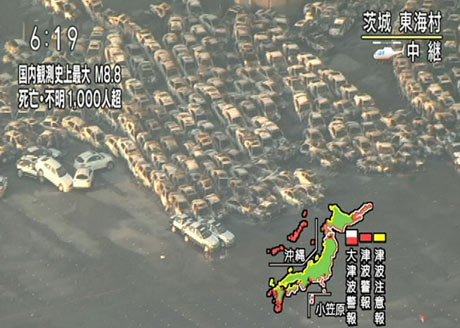 A screenshot from NHK television of burnt out cars near a nuclear power plant in Tokaimura, Japan. Photograph: AP/NHK TV
A screenshot from NHK television of burnt out cars near a nuclear power plant in Tokaimura, Japan. Photograph: AP/NHK TV
Some grim footage from Japanese television. This screengshot is of a carpark in Tokai – a coastal town in in Ibaraki prefecture – showing cars that were first pushed together by the force of the tsunami, and then caught fire.
The damaged Fukushima Daiichi nuclear reactor may have already been leaking radiation outside the plant, confirms Japan's nuclear safety agency and the operator, the Tokyo Electric Power company.
Compared with the government briefing last night that everything was fine, that's a turn around.
According to AP, the continued loss of electricity has delayed the planned release of radioactive vapor from inside the reactor to ease pressure. Pressure inside one of the reactors had risen to 1.5 times the level considered normal.
The Daiichi site is located in Onahama city, about 170 miles (270km) northeast of Tokyo. The 460-megawatt Unit 1 began operating in 1971 and is a boiling water reactor that drives the turbine with radioactive water.
Now there are reports from nuclear plant operator Tepco that the Fukushima Daini plant has lost cooling to three of its reactors.
It was one reactor in the Fukushima Daiichi plant that had been the cause for concern earlier – so this news is certainly unwelcome.
According to Dow-Jones, Tepco says that the temperatures of its No 1 and No 2 reactors at its Fukushima Daini nuclear power station are rising, and it has lost control over pressure within the reactors.
Fukushima Daini station is the second nuclear power plant the company has in Fukushima prefecture in northeastern Japan, where the troubled Fukushima Daiichi plant is located.
The Kyodo news agency is reporting that the Japanese government is ordering Tepco to open valves on the Fukushima Daiichi No 1 reactor to release pressure.
The Fukushima Daini plant has now been added to the government's emergency list.
Earlier, Tepco – the Tokyo Power company – had reported:
A seriously injured worker is still trapped in the crane operating console of the exhaust stack and his breathing and pulse cannot be confirmed.
This is more chilling news from Kyodo:
The cooling system failed at three reactors of the quake-hit Fukushima No 2 [Daini] nuclear power plant Saturday, the operator Tokyo Electric Power Co said.
The company, which has already scrambled to deal with radiation leaks at its Fukushima [Daiichi] No 1 plant, notified the industry ministry that the failsafe system at the No 2 plant stopped functioning as the temperature of coolant water has topped 100C.
So much for the "failsafe system", which appears to have failed.
Meanwhile, Japan's nuclear safety agency is set to issue an unprecedented order for Tepco to open a valve at the damaged Fukushima Daiichi nuclear power plant to release pressure, as we reported earlier.
The good news is that the 3,000 residents in the initial evacuation radius have been safely removed.
 The Fukushima Daiichi or No 1 nuclear power plant
The Fukushima Daiichi or No 1 nuclear power plant
In the comments, many people are asking what the implications of the nuclear reactor power failure is. Given how little we are being told by Tepco and the Japanese government, it's hard to say. The increase in background radiation near the plant isn't dangerous at this point, but of course that could change.
Reuters has a piece explaining what happens when a reactor loses coolant:
When all sources of power fail like at the Fukushima Daiichi plant, coolant begins to boil off, exposing the fuel rods. It would likely take several hours to boil off enough coolant before the core is hot enough to damage it.
If the fuel rods became damaged they would release radioactive material into the remaining coolant.
- Hours beyond that the metal surrounding the ceramic uranium fuel pellets could potentially start melting if temperatures reach well beyond 1000F as occurred at Three Mile Island. The ceramic fuel pellets would not melt until temperatures reached about 2000 degrees F.
- Hours after the fuel rods started to melt, the heat could potentially melt through the reactor vessel, which is made of high tensile steel four to eight inches thick
- It would take even more time before the containment fails, which could result in radioactive releases to the environment. The containment is an air tight steel or reinforced concrete structure with walls between four to eight feet thick.
As the Three Mile Island accident showed, operators can regain control of the situation if they can get the coolant flowing again.
For informed commentary on the nuclear reactor problems in Japan, those of you with Twitter accounts should follow @arclight who appears to know the stuff.
Japan's urban search and rescue team left New Zealand today to return to Japan, having been working in Christchurch since last month:
The team was planning to leave Christchurch this weekend, and brought forward their departure time in response to the earthquake and tsunami that struck Japan last night.
Civil Defence National Controller Steve Brazier thanked the team members for their efforts in assisting with the Christchurch rescue efforts. He sent his condolences to the people of Japan in the wake of yesterday's earthquake and tsunami.
A number of readers have raised Chernobyl in comparison to the events at the Fukushima plants.
The Chernobyl disaster was caused by a power surge and subsequent explosion that caused a fire. The situation in Fukushima (from what we know) is power failure shutting down reactor coolant systems, and the failure of back-up generators.
Scientific America is on the case with an excellent explanation of what's going on at the Fukushima nuclear plants:
Tokyo Electric Power confirmed that pressure had been rising inside reactor No. 1 at its Fukushima Daiichi nuclear power plant on the northeast coast, one of the largest nuclear power plants in the world. That means cooling water is not getting to the reactor core, causing a build up of steam inside the containment vessel. The problem, according to Japanese media reports, is a loss of grid electricity to run the pumps that bring in cooling water. The backup diesel generators that are supposed to provide emergency power in that case are out of order, according to the Japan Atomic Industrial Forum, but replacements were being taken to the plant.
Scientific America's David Biello has an interview with Scott Burnell, public affairs officer at the US Nuclear Regulatory Commission:
What happens when a reactor gets disconnected from the grid?
There are emergency diesel generators. You also have a battery system to keep instruments running, but that can also provide power to safety systems [which prevent a meltdown by cooling the reactor core]. It's all meant to provide defense in depth. First you rely on the grid. If the grid is no longer available, you use diesel generators. If there is an issue with the diesels, you have a battery backup. And the batteries usually last long enough for you to get the diesels going.
Now an official from Japan's powerful trade ministry is telling news organisations that Tepco is "also considering releasing pressure" at the Fukushima Daini nuclear plant.
The government has also just ordered the evacuation of a three kilometre radius around Fukushima Daini plant – following the previous evacuation order of a 10km radius around Fukushima Daiichi.
Given the events at the Fukushima plants, other useful Twitter accounts worth following on the subject: the International Atomic Energy Agency @iaeaorg and the US Nuclear Energy Industry @N_E_I (and yes I know they are a lobbying outfit for the industry but they are following events in Japan).
Some expert comment from Professor John Luxat, chair in nuclear safety analysis at Canada's McMaster University:
What seems to have happened at the Fukushima nuclear plant?
It's very difficult to make definite conclusions at this point because information is coming in bits and pieces. What we do know is that when the quake hit the reactors at Fukushima [Daiichi], there were three of the reactors up and running – the other three were shut down for regular inspection. The three that were up and running immediately shut down, as they are designed to do when the ground shakes above a certain level.The emergency backup diesel generators that provides electricity to the shutdown cooling system operated as designed for about an hour, and then they failed for some reason that's not clear. They lost power to the pumps providing cooling water. Reports are that they have brought in backup generators and hooked them up.
One reactor is reported to have a slightly greater problem with cooling, which is not fully clear.
At this stage, they need to reestablish the electrical power supply to the cooling system.
The other thing is that the containment buildings haven't suffered any reported damage. The plants are designed to strict seismic requirements because they're in an earthquake region in Japan, and there's no reported damage to these structures. The function of a containment building is to contain any radioactive material released from the reactor and limit any subsequent release outside the plant.
Events have moved on slightly since then but this is still an illuminating explanation.
The Japanese government is currently holding an emergency meeting on the subject of the Fukushima nuclear plants.
The latest from the Fukushima reactors is that the government is now saying that there has been "no radioactive leak so far" at the nuclear plants. That seems to contradict an earlier statements by Japan's nuclear safety agency and the Tokyo Electric Power company.
Update: no, it seems the government meant that the plant was leaking through damage, as opposed to venting steam containing radioactive material, which has already happened.
The two nuclear plants currently having difficulties need some explaining, to keep everything clear. Here's what we know:
• Diesel generators that normally would have worked as back-ups to keep cooling systems running had been disabled by tsunami flooding.
• Power supply systems to provide emergency electricity for the plants were being put in place, the World Nuclear Association said.
• Both plants are light water reactors operated by the Tokyo Electric Power company (or Tepco):
Fukushima Daiichi (No 1) plant
- has six reactors, three of which were shut down for maintainence. Two of the remaining reactors, Unit 1 has significant problems with a rising temperature and in another the operator says it has lost cooling ability.
– the Unit 1 reactor has seen radiation levels inside its control room rise, and slightly higher radiation levels have been detected outside the reactor. Pressure inside the reactor is twice the normal level, and the operator has been forced to vent radioactive vapor to relieve the pressure.
Fukushima Daini (No 2) plant
– has four reactors, and in units 1, 2 and 4 of them the operator has said it has lost cooling ability.
– Tepco says pressure is stable inside the reactors of the Daini plant but rising in the containment vessels.
• Both plants have been declared to be in a state of emergency by the government, and residents moved outside of a 10km zone around both plants.
Time to close this part of the live blog for the evening, thank you for reading. The Guardian's coverage will continue on a new live blog here.

